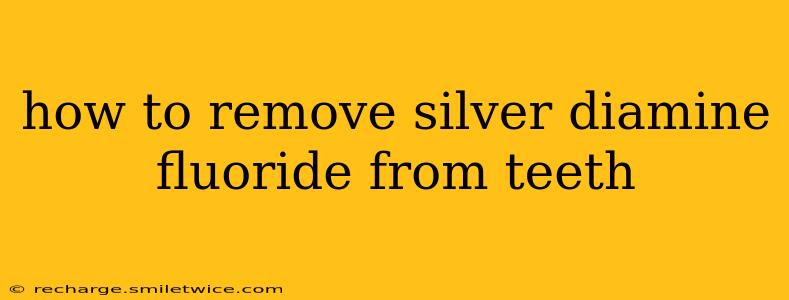Silver diamine fluoride (SDF) is a highly effective treatment for arresting dental caries (cavities), particularly in high-risk patients. However, its use results in a noticeable black or brown staining of the affected tooth surfaces. While the staining is generally considered a cosmetic issue, many patients understandably want to know how to minimize or remove the discoloration caused by SDF. Unfortunately, completely removing the stain is often challenging. This article explores various approaches and considerations.
What is Silver Diamine Fluoride (SDF)?
Before delving into removal methods, it's crucial to understand SDF's purpose. SDF is a topical solution containing silver ions and fluoride ions. The silver ions have an antimicrobial effect, killing bacteria responsible for cavities, while the fluoride ions help remineralize the tooth enamel, strengthening it and preventing further decay. Its primary advantage lies in its non-invasive application, making it ideal for managing cavities in young children or patients with special needs who may struggle with traditional dental procedures.
Can You Remove SDF Stains Completely?
The short answer is: not completely and easily. The silver ions that cause the staining penetrate into the tooth structure, making total removal difficult. While some methods can lighten the discoloration, achieving a perfectly white tooth might not be possible, especially with deeper staining.
How to Minimize or Lighten SDF Staining
Several approaches can help minimize or lighten the appearance of SDF staining. These methods vary in effectiveness and may require professional dental intervention:
1. Professional Cleaning and Polishing:
A thorough professional cleaning and polishing by a dentist can often remove superficial staining. This involves using specialized instruments and polishing pastes to gently remove surface-level discoloration. This is often the first step recommended after SDF treatment.
2. Air Abrasion:
Air abrasion uses a fine stream of abrasive particles propelled by air to remove stained tooth surfaces. This technique is less invasive than traditional drilling but may not completely remove deep staining. Its effectiveness depends on the extent and depth of staining.
3. Resin Infiltration:
This technique involves applying a resin material to the stained areas to mask the discoloration. Resin infiltration isn’t designed to remove the SDF but rather to improve the aesthetics of the stained tooth. It's a viable option for mildly stained teeth.
4. Whitening Treatments:
While traditional teeth whitening (like at-home kits or in-office bleaching) may offer some improvement, they are often less effective at removing SDF stains compared to the professional methods mentioned above. The effectiveness of whitening on SDF stains is highly variable and depends on the depth of penetration of the silver ions.
5. Veneers or Crowns:
In cases of severe or extensive staining that significantly impacts aesthetics, veneers or crowns might be considered. These are more invasive cosmetic procedures where a thin shell (veneer) or a full cap (crown) is placed over the stained tooth to completely conceal the discoloration. This is typically a last resort due to the cost and invasiveness.
Will SDF Staining Fade Over Time?
Some patients report that SDF staining fades slightly over time, although this is not a guaranteed outcome. The degree of fading depends on individual factors, the depth of staining, and oral hygiene practices. While waiting for potential fading might seem appealing, it’s crucial to discuss management expectations with your dentist.
How Can I Prevent SDF Staining?
While SDF staining is a common side effect, some techniques can help minimize it:
- Careful Application: Precise application of SDF by a trained professional can reduce the amount of staining.
- Thorough Isolation: Keeping SDF contained to the target area through proper isolation techniques during application is important.
- Post-Treatment Rinsing: Following your dentist's instructions regarding post-treatment rinsing can help minimize excess staining.
Is SDF Staining Harmful?
It's important to reiterate that SDF staining itself is not harmful. It is purely a cosmetic concern. The benefits of preventing further decay far outweigh the cosmetic drawbacks for many patients, especially those at high risk of cavities.
Conclusion
While completely eliminating SDF stains is generally difficult, various methods can effectively lighten or mask the discoloration. The best approach depends on individual circumstances and the extent of staining. Always consult with your dentist to determine the most appropriate course of action. They can assess your specific situation and recommend the treatment option that best meets your needs and aesthetic goals.
